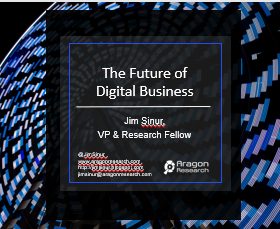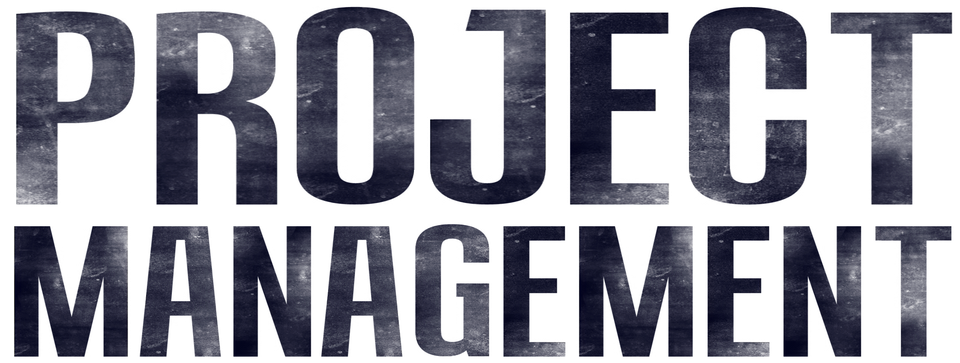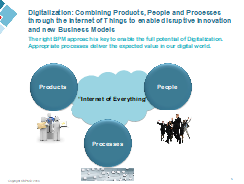Home / Resources
Resources
Discover a Wealth of BPM Knowledge and Expertise at BPMInstitute.org!

The Future of Digital Business
The top three digital destinations are new business opportunities, better customer loyalty and better business results.
No organization is too big to fail. The avg tenure of a S&P 500 company is forecast to shrink to 14 years by 2026. Large companies are feeling the pressure from customers and competitors to “go digital” more and more everyday.
It starts with digital mini journeys.
Register for this webcast to find out what the top ten fool proof digital mini journeys are.

Essential Skills for Digital Business Leaders
A successful digital business initiative relies upon adopting agile principles, an enduring focus on improving customer experience and executing programs with a business process based view with enabling digital information technology.
Measuring what matters to customers and challenging the current operating model of the business are two important characteristics of digitally mature organizations.
Join Gregg Rock and our leading digital business experts as they discuss the critical skills needed in your digital transformation initiatives:
- Introduction to Digital Business
- by Andrew Spanyi
- Design Thinking Applied
- by Clay Richardson
- Robotic Process Automation
- by Cornelius Pone
- Digital Customer Experience
- by Andrew Spanyi

The Pace Setting Business Architect: Lessons From the Field
You don’t need me to tell you that the pace of disruption and change in business is already immense and is accelerating. The Wall Street Journal several years ago published an interesting comparison of how long it takes for a new product to reach 50 million users. Updates to this have been popping up all over social media recently that demonstrate the acceleration:


How to Be Agile in a Non Agile Organization (Part 2): Aligning Agile projects to corporate reporting structures
This is the second in a series of articles that will give you strategies for aligning your Agile work to your organizational structures. The first article focused on delivering Agile projects within existing Project, Process and Quality Management frameworks. In this article, the focus is on delivering Agile projects within the existing corporate reporting structures of your organization.
Agile approaches provide a number of mechanisms for tracking progress, including formal reports (e.g. executive dashboards), status update tools (e.g. WIP boards and product backlogs), and ongoing communication with stakeholders.
The ideal Agile reporting environment would leverage these tools without asking staff to do extra (often redundant) work to meet corporate reporting requirements. Specifically, this would involve using:

Business Process Modeling in Higher Education Institutions
Embrace business process modeling!
All higher education establishments, from small colleges to large campus institutions, are involved in some complex processes to deliver effective teaching and learning. It is usually plain to see that there is room for improvement for the methods used. The issue now becomes, how do they tackle the problems and what do they tackle first? The implementation of new systems then becomes imperative since it’s usually a drive for considering how to carry out the business process.
Business process modeling is the graphical representation of a company, in this case, higher education institutions, as a means to identify potential improvements. They can achieve this through different graphics methods such as data flow diagrams or the use of flowcharts among other types. 25% of organizations worldwide are conducting training in business management systems, so quite a number of institutions are getting onboard.

Big Data: A Lure For Businesses Today
Businesses from across the globe – both large enterprises and small and medium businesses – want to improve their operations and advance. This is where technology is crucial. Data science and analytics is changing the way we do marketing and has given us many new opportunities for profit, growth and so on.
Big data analytics is enabling enterprises to do many tasks in real time and with ease. This rapid digitalization has given companies many new opportunities and choices.
Global revenues in big data and business analytics has increased from $130 billion to more than $203 billion in the future.
Big data science and analytics include statistics, math and many other mechanisms which enable companies to analyze data and get valuable information from it. The amount of data is increasing with each day.

7 Agile Concepts You Can Apply Successfully to IT Areas Other Than Software Development
Agile is an iterative form of software development. Through its rituals and ceremonies, it provides a quicker way to deliver value to the actual customer of the software. Through its focus on prioritization, agile insists that the work most important to the customer be completed first. Through its dedication to team empowerment, agile pushes the “how” to the team level where the team takes ownership of delivery and quality. As agile has proven its value in the software engineering field, it also has many concepts that can prove beneficial to other IT areas. Listed below are some of those concepts and examples of how they might be implemented.

How to Write a Business Process Management Project Charter
When a business standardizes one of its processes, it is justified, financed and sustained within the boundaries of a business process management project charter. Therefore, a project charter defines the issue to be resolved, the scope and the goals of the undertaking and the roles and responsibilities of the parties involved. It is a contract between the management and the team that will implement the change.
In light of the above, this article will highlight how to write a business process management project charter.
To start with, there is no single way to write a project charter. The length and format are purely in the prerogative of the writer. However, if you want it to be read, write a brief one. The ideal project charter should be 2 pages maximum; if you really have to exceed this, then 5 page is your final limit.

Agile HR: Highly Skilled vs. The Team Player
I worked with an Agile Coach who used to be a development manager and was famous for telling people he could expect a 5-10% attrition of his employees when Agile was getting introduced. It begs the question of why in the world an organization would be willing to undergo such a disruptive change in how they work, knowing that such a large portion of their current staff will consider leaving because of it? For many organizations, the answer became self-apparent. They have recognized the need to be faster, more adaptive in their market. They became self-aware in knowing that, without such a change, they would quickly become an afterthought. So, the need for change is apparent but how does an organization deal with the inherent personnel issues that could come with adopting an Agile culture? By not taking this part of the change into serious consideration, you could be inadvertently undermining your entire transition into an Agile organization!

An Initial State Process to Accelerate Innovation
When analyzing a function for improvement, it is common practice to document the existing operations into what is widely known as a current state. This current state operational view serves as a baseline for improvements. It identifies the inputs, work steps, and outputs (and often a lot more). It serves to ground the team and provide a starting point for designing a future state. In contrast, future states are the destination. They are the sum total of the improvements to the current state to get to a new more effective and efficient operational state. Generally current state and future state views are documented as process maps or flows. Both the current state and the future state are powerful steps for improvement teams to understand where they are today and where they are going in the future.

How to Lead When Building a Business Capability Model
If you are leading your organization’s business capability model (BCM) development, here are some guidelines that you can follow.

Robotic Business Process Automation is Here
Robotic Business Process Automation is all the rage right now. It is the new cost reduction initiative that many executives are eager to implement. There are numerous conferences focused on Robotic Process Automation (RPA) and the evolution to Cognitive Processing or Machine Learning (AI). There are many emerging companies that show great promise and businesses are strongly considering adopting these tools. The following from Accenture, is a succinct depiction of the spectrum of Robotics, with RPA being the simpler end of the spectrum.


Meet the Author: Dr. Mathias Kirchmer, High Performance Through Business Process Management
Strategy Execution in a Digital World
This management book presents value-driven business process management as a successful discipline to turn strategy into people-and technology-based execution, quickly and at minimal risk. It shows how to achieve high performance successfully in a digital business environment.

How Agile is your Operating Model?
Let me start with a definition of agile as it applies to operating models or processes: “being able to turn on a dime for a dime” and “being able to change faster and more cheaply than your competitors”. These phrases are taken from, who was part of the team who coined the term agile as being relevant to the lean and six sigma community. In this community, agile is associated with short-period (often six-week), test-and-learn projects, at the end of which priorities and direction can be reset based on what has been learned. It is also associated with “minimum viable product”: the way of testing a new idea.

Using BPM to Meet Today’s Investment Management Industry Challenges
In today’s demanding business environment that rewards flexibility, speed, quality, efficiency, effectiveness and innovation, a strategically competitive middle- and back-office strategy and its operational execution can be a roadmap to achieve sustainable competitive advantage. Business Process Management (BPM) helps an asset management company achieve these characteristics in the components of its value chain. Applying the BPM discipline achieves measurable process improvements that lead to organizational performance improvements in the middle- and back-office.
Middle- and BACK-OFFICE challenges

How to Be Agile in a Non Agile Organization (Part 1):
Delivering Agile Projects within Structured Project, Process and Quality Management Frameworks
The most important factor in successful Agile adoption (and expansion) is aligning it to the culture, standards and constraints of your organization. Even the most effective Agile project work risks losing executive support if it cannot meet the overarching management, compliance, administrative and reporting structures established by the organization. Unless you are in the unique position of being able to adjust your organizational structures to suit the flexibility of Agile approaches, you will need to find a way for your team’s Agile work to comply with these corporate standards. Thankfully, this is an achievable goal, although it may take some creative thinking to make it work within your specific organizational constraints.

Lessons from the Field: The Bold Business Architect
Picture this: you get this fabulous opportunity to work with a business on bringing its new strategy to life. They share with you the fanciest PowerPoint slides you have ever seen describing their vision, mission, and the tremendous opportunities they see in the marketplace and how uniquely they are positioned to gain market share. You dive right in and open up your business architecture toolbox and get to work. You map out their strategy, document the business model, create a capability map and conduct a maturity assessment. Life is great and the energy level is high. As time goes on, though, you start to get an odd feeling that something isn’t right. You find pockets of disengagement across the organization. You are finding a growing number of major capability gaps. There are parts of the organization you really can’t figure out what they do. And worst of all: you can’t figure out why anyone would really choose to buy from your company versus a competitor.

The Challenges in Deploying Operational Excellence
Deploy: to organize and send out (people or things) to be used for a particular purpose; to open up and spread out the parts of (something, such as a parachute). Source: Merriam-Webster’s Learner’s Dictionary
Organizations face many challenges when trying to deploy or redeploy an improvement program. So much of the success of any initiative depends on how it is implemented and used by the organization. To be successful, you must consider what is the correct method to use, what are the change management issues, and how it will be deployed. A one-size-fits-all mentality will not work in any of these three areas.
It all begins with culture
We must begin with self-examination of the current culture in your organization. Several questions must be answered:

Disruption, Innovation and the Art of Business Architecture
Over the past decade, the Business Architecture community of practice has built a firm foundation of methods, practices and tools that allow organizations to map their place in the business world, assess the viability of their capabilities, and chart a course towards their future. And yet, Business Architecture still has a long way to go to permeate the public consciousness. In fact, while concepts such as change, disruption, and innovation have fired up the imagination of entire industries, Business Architecture’s public brand as a game-changer has drawn more muted reactions, as the Google Trends diagram below starkly demonstrates.

Figure 1: Google Trends graph (dated 9/16/2017), keywords: disruption, innovation, Business Architecture
The Complex Organization

Enticing Executives with Visual Analysis
Once you have your current state model, what do you do with it? How do you share it with the Process Owner and Executive Sponsor and spark their interest? My experience is that executives looking at a model that is 30 to 60 steps long are impressed and say something like, “Wow, that process is complex. I can see it has a lot of steps which could take a long time.” But they are not interested in reviewing every single step and getting into the details.













